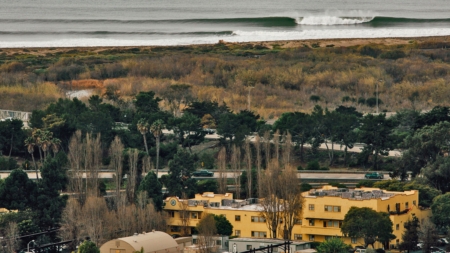Fire Up the Test Tank
There’s nothing more important than having waves a few minutes away.
It’s only minutes for Hub Hubbard to get from his desk to our wetsuit testing facility. Hang a left, merge onto the 101, exit to the right, pull over and park. From there it’s a few seconds to step into a suit and paddle out into the wave tank, all 187 quintillion gallons of it, more commonly known as the Pacific Ocean.
Being able to continually test, challenge and refine designs at home in Ventura is what makes our wetsuit program possible. It’s allowed us to progress our suits, in a little over a decade, from the first stiff prototypes to our current Yulex® line that uses natural rubber to offer the highest levels of comfort and stretch. There are plenty of surf options within short striking distance of the trailer where we built our concept suits—punchy peaks, racetrack points and, in the depths of winter, some heavy-duty spots best left unnamed. All of them provide diverse opportunities to assess how new suits work and feel in the water.
“We’re lucky to have so many waves close to us,” says Hub, who’s been our wetsuit line manager for about five years. “And testing is just a natural part of our routine. I’ll drop the kids off, check my email and then get in the water at least once or twice a day. I use the gear constantly, trying out different iterations of foam, construction and fabric. We’re also as hard as possible on the suits—I’ll grind them into the gravel when I’m changing, leave them sandy and salty in my car, never wash them, dry ‘em in the sun. It’s the only way to find out how they’re going to last.
“Sometimes we’ll try one thing,” he continues, “like a lining that dries faster. But then we’ll find out it doesn’t feel great on the skin. So we’re always learning and then taking the steps to perfect a product. And being able to build our protos right here, and surf them that same day, is huge. If you’re a company sending drawings out to a factory to build, it can be two months before you’d even get a sample back.”
Along with a core group of in-house testers that includes Andrew Reinhart, Amanda Powell, Fletcher Chouinard and the shop staff at FCD Surfboards, Hub’s testing has dual purposes—trying out experimental technologies while making sure the suits that are almost final are as refined as possible before going out for further testing with our surf athletes around the world. Sometimes the process means sticking out a little in the lineup, like the guys who ended up looking like Tron when a seam tape sample came out white instead of black. But mostly it’s just surfing as much as possible and taking note of what still needs adjusting.
“I’m out there even if there are only ankle-high waves that I can get a little noseride on,” notes Powell, who holds a day job as our digital advocacy coordinator for Patagonia Action Works. “I’ll zip down on my bike and get as many waves as I can in the time I have. Mostly I’m looking for flexibility, comfort, warmth and ease of getting in and out of the suit. If I notice the suit minimally, or not at all, while I’m surfing—that’s an ideal wetsuit in my book.”
Ultimately, it’s the test crew who make the call on what’s ready and what’s not.
“We all know what a great suit feels like, so I’m looking for a thumbs-up from everybody,” Hub says. “And our crew can be brutally honest. So that’s our final determination—when everyone here gives it the green light.”

